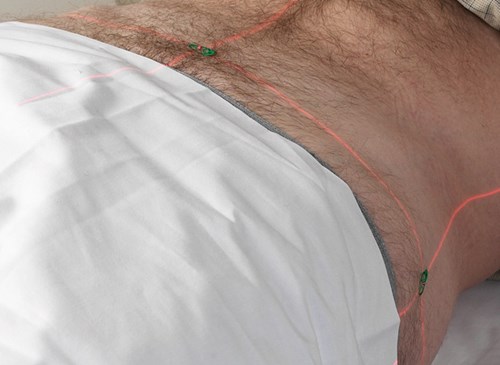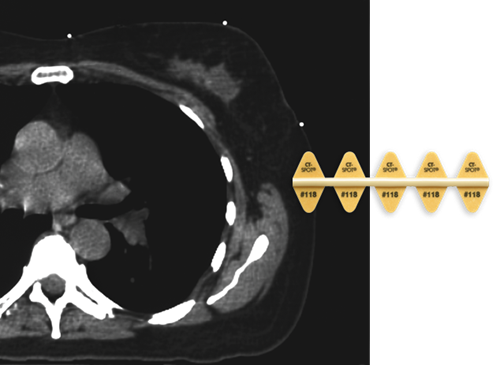
Conventional Simulation Markers
Differentiate specific points of reference in conventional simulation and port films Burnout resistant skin markers improve accuracy, save time Conventional simulation differs greatly from CT simulation in that the tumor is localized in only two dimensions. Burnout may occur in conventional simulations when the beam over-penetrates an object and produces an overexposed area on the image. When this happens, the patient must either be re-simulated, or the dosimetrist must contour the body shape so that an accurate dose distribution can be calculated for treatment. Metallic pellets, line, and arrow offer a broad range of use in conventional simulation Skin markers act as a guide for radiation oncology teams who want to be sure the right tissue is being irradiated. They also help reduce the concern a dosimetrist may have with manually contouring the image due to burnout. MED Tech AS Medical’s SPOT® skin markers for conventional simulation image brightly and serve as guides for determining isocenters and 3-point set-ups. Burnout resistant, this family of metallic pellets, line, and directional arrow are used to identify critical structures and areas of concern and mark field borders, breast tangents, scars, match lines, outer canthus, and nodes.

CT Simulation Skin Markers
Radiation Treatment Accuracy Starts Here Unique non-metallic pellets, crosshair, and line image brightly under CT simulation without streaking or artifact Precision in CT simulation affects subsequent radiation treatments. The goal is to destroy cancer cells without doing harm to nearby healthy tissue. With accuracy measured in millimeters, the quality of each tool the radiation therapist uses for set-ups and treatment planning makes a difference. Streak artifact from high-attenuation materials, such as metallic markers can distort the true density of normal tissue and affect radiation dosage calculation. As a result the dosimetrist spends more time trying to factor out the distortion and match the affected tissue with the houndsfield units of nearby tissue unaffected by the distortion. Artifact can be an avoidable obstacle for the radiation oncology team Low density self-adhesive CT-SPOT® skin markers for treatment planning are designed to image brightly on every slice and reduce with minimal streaking or artifact in CT treatment planning. CT-SPOT pellets, crosshair, and line help to reduce the amount of time the dosimetrist spends autocontouring images while remaining a bright visual aid for the interpreting radiation oncologist.

PointGuards® Temporary Mark Covers
Accurate Day-to-Day Reproducibility of Setups During Radiation Treatment Precut clear adhesive covers provide a watertight seal and stay securely in place for up to 4 weeks Temporary marks are an important part of CT-Simulation when permanent tattooing is not a viable option for the patient to ensure accurate and reproducible setups for treatment. However, temporary marks are only helpful when they stay on throughout the course of treatment. Unprotected marks can fade and wash off resulting in the patient being re-simulated before continuing treatment. PointGuards are the fast and convenient way to protect a patient's temporary marks from disappearing during the course of treatment. Less irritating to skin than surgical tape, pre-cut PointGuards provide a watertight seal that stays securely in place for up to 4 weeks. Choose PointGuards circular covers for smaller treatment marks Choose PointGuards linear adhesive covers for longer, more linear treatment marks Choose PointGuards crosshair for hard to find treatment marks

TenderTouch™ cushioned tape for thermoplastic masks
Provide Maximum Patient Comfort During Head and Neck Radiotherapy Treatments Soft, durable cushioned tape molds easily around cut edges of thermoplastic masks Many of those diagnosed with head or neck cancer will undergo radiation therapy. To prevent accidental movement and prevent irradiation to healthy tissue, some patients may be fitted with a thermoplastic mask to wear during the course of their treatment. During the course of treatment, which may be as long as 8 weeks, some patients' masks are cut due to swelling and tightness, anxiety and claustrophobia, sensitive skin, or to enable the use of bite blocks, bolus, or electron fields. A professional product designed for patient comfort and durability A soft-to-the-touch, scored, and cushioned tape that easily molds around the ragged edges of cut thermoplastic masks to provide comfort to the patient and relieve pressure points. TenderTouch sticks consistently to the thermoplastic material to provide the patient with optimal comfort throughout treatment. Not made with natural rubber latex. Hypoallergenic.

X-Line™ Body Contour Tape for Radiotherapy
Clear Visualization of Body Anatomy that Extends Beyond the Scan Field of View X-Line radiotherapy tape is an alternative to image reconstruction software, fusing multiple CT scans, or just plain guesswork. Simply connect the dots on the image to accurately delineate the external body contour of obese patients in the extended field of view (eFOV). This fully adhesive transparent tape is applied to regions of the body that fall outside the scan field of view (sFOV) but are within the extended field of view (eFOV) of your CT simulator. X-Line’s three radiopaque lines create hyperdense dots in CT image slices making it easy to identify the true body contour. X-Line is distributed by MED Tech AS Corporation to U.S. customers only.
